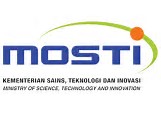Agensi Nuklear Malaysia – Nuclear Technology for Malaysian Sustainable Development
Introduction
On September 25th 2015, at the United Nation (UN) Headquarters in New York, member countries adopted a set of goals to end poverty, protect the planet, and ensure prosperity for all as part of a new sustainable development agenda. Each goal has specific targets to be achieved over the next 15 years. Altogether there are 17 specific goals ranging from poverty, hunger, health, clean water, affordable clean energy, climate change, environment, industry, innovation etc. For the goals to be reached, everyone needs to do their part: governments, the private sector, civil society and people like us.
The International Atomic Energy Agency (IAEA) one of the agencies under the UN, is mandated to prevent the spread of Nuclear Weapon. However, another key role of IAEA is to make nuclear science and technology available to member states to ensure that development and progress are sustainable. The main focus areas are electricity generation, improving human health, increase food production, industrial enhancement, mitigate problems related to climate change, etc. Since joining IAEA in January 1969, Malaysia has benefitted enormously from assistance and collaboration in the development of human resources, expertise and development and application of nuclear science and technology. Malaysia through the Malaysian Nuclear Agency (Nuclear Malaysia) as well as other agencies has participated in numerous collaborative projects regionally or inter-regionally and outputs of these projects have been successfully adopted by various socio-economic sectors.
The establishment of a Nuclear Agency in Malaysia was mooted from an idea of the late Malaysian Deputy Prime Minister, Tun Dr Ismail Dato’ Abdul Rahman, that Malaysia should be enhancing and benefitting from the development of nuclear science and technology for peaceful purposes. Neighbouring countries such as Indonesia, Thailand, Philippines and Vietnam had their nuclear research centres equipped with research reactors since early 60’s. Following the oil crisis of the early 1970’s and nuclear energy was considered as alternative, the Cabinet then officially approved the establishment of the Tun Ismail Atomic Research Centre on 19 September 1972. The era of nuclear in Malaysia began when the Reaktor TRIGA PUSPATI reaching its first criticality on 28 June 1982.
Currently, Nuclear Malaysia is equipped with major facilities such as Nuclear Research Reactor, Gamma Irradiator, Electron Beam Machine, Radioisotope and Radiopharmaceutical Production Facility, Radioactive Waste Treatment Centre, and various other nuclear equipments. Apart from that, nuclear science and technology is also used in hospitals, manufacturing, various industries, universities, as well as in agricultural practices. Since operational in 1984, Nuclear Malaysia has embarked into the development of applications and promotion of Nuclear Technology in sectors namely Energy, Medicine, Industry, Food and Agriculture, Environment, Water and Soil Management and development of New Materials.


View of Nuclear Malaysia complex then and now
Reactor Technology and Application
Nuclear Malaysia has been operating a 1 MW research reactor for more than 30 years in a safe and peaceful manner. The research reactor has been used for radioisotope production for medical and industrial uses. The reactor other main uses are for the analysis of environmental samples and industrial materials as well as for education and training in reactor design and engineering. Annually more than 3000 samples are analysed by using the reactor which has benefitted industries, researchers as well as the education sector. Without this reactor such analysis and research has to be carried out overseas.
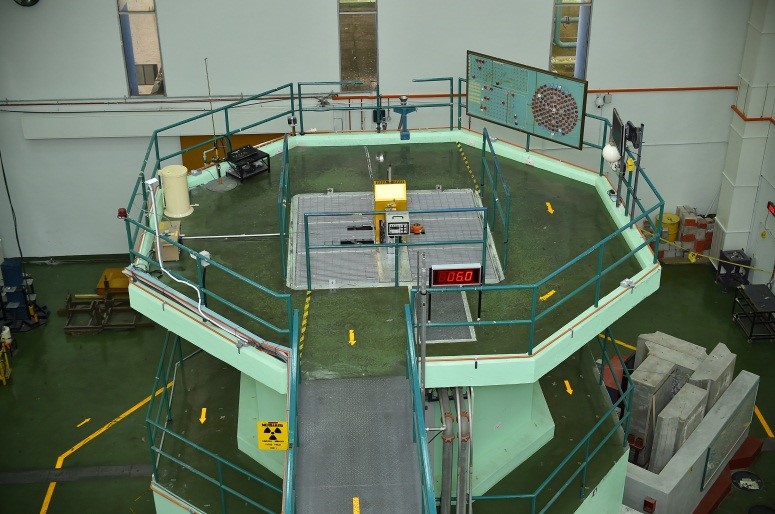
Reactor TRIGA PUSPATI – Top view

Reactor pool

Reactor control console

Closeup view of the reactor top
Industrial Applications and Development of New Materials
Industrial testing using nuclear technology (X-Ray and Gamma Ray) has contributed tremendously to the competitiveness of Malaysia’s manufacturing and industrial sector. Since companies can have access to a good quality non-destructive testing (NDT) services at reasonable cost, have allow them to spend money on inspection, and thus improving Malaysia’s competitiveness as well as the level of safety of facilities such as oil refineries, manufacturing plants as well as gas plants. Prior the development of local NDT industry and accreditation system for testing services, PETRONAS and other oil companies in Malaysia had to rely on foreign NDT providers, or local companies hiring operators certified abroad. Oil pipes, boilers, pressure vessels, aircraft components and ships, especially joints and welds are among the products whose quality and integrity are tested with the technique. With the assistance of IAEA, Nuclear Malaysia and skill accreditation agencies have successfully established accredited training and certification system that meets international standards. Malaysia has also built itself an export niche in South-East Asia and the middle-east, offering NDT using nuclear technique to industries. Currently there are over 100 NDT companies in Malaysia, employing more than 1000 certified engineers and technicians to carry out NDT testing. The success of Malaysia in this area has been acknowledged by IAEA. Malaysian experts have been deployed in numerous developing countries to assist in the development of similar scheme.
Apart from developing technique and certification in NDT, various instruments and detection systems are developed for plant evaluation purposes. Examples are density, moisture, thickness, corrosion as well as material interface gauges that utilises radiation in the sensing systems.

Mobile Gamma Tomography For Industrial Material Inspection
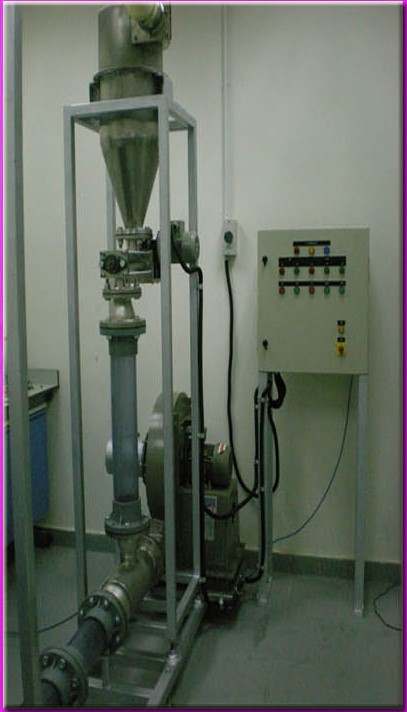
Solid & Gas Flow Test Rig

Pipe Corrosion Gauge

Moisture detection in concrete
By using radiation technique numerous new materials have been developed world-wide. In Malaysia, use of indigenous resources such as palm-oil, rubber, kenaf and petroleum products has been the focus. New composites and polymeric compounds have been developed from these sources are used in industry, for making medical kits and others. Nuclear Malaysia is collaborating with PROTON, a national car manufacturer to produce and test radiation induced cable insulation material which can withstand higher temperature so as to enhance car safety.
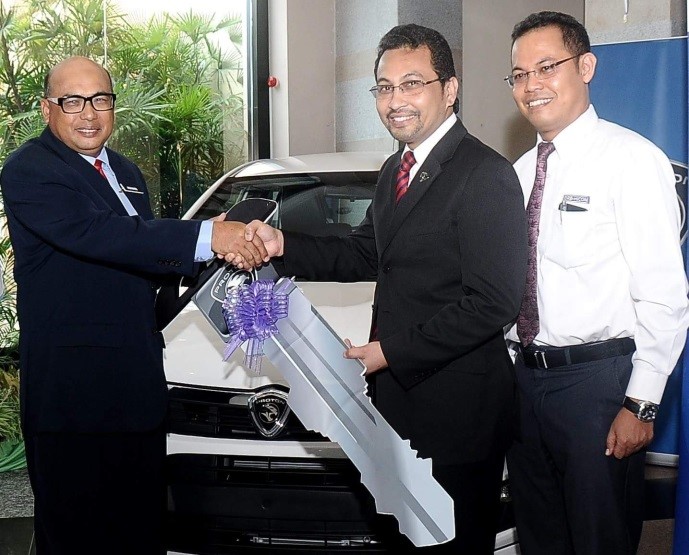
Nuclear Malaysia receiving a Proton test car for a project on cable material and insulation
Another area that radiation technology has contributed immensely to the socio-economic development in Malaysia is in the sterilisation of medical kits such as catheters, surgical gloves, syringes as well as contraceptive sheets. In the 1980’s there were only a few surgical glove manufacturers as well as other medical products in Malaysia. These manufacturers have to sterilise either by other method which is less preferred by the industry or to get it done by radiation method overseas. This was rather difficult to new entrepreneurs. Due to increasing demand for sterilised medical products and kits at that time, Nuclear Malaysia had promoted to companies to invest on gamma sterilisation technology. However due to uncertainty on the return of investment and the complexity of the technology no company was willing to invest. In 1989 with the budget provided by the government, Nuclear Malaysia commissioned a gamma sterilisation plant for research as well giving services to the rubber medical glove and other medical products industries. The business model of this semi-commercial plant was very successful in demonstrating the technology and it was also a catalyst in the growth of medical products manufacturing industry. The business model was adopted by a company called Sterilgamma Sdn. Bhd where a similar plant with higher capacity was built in Rawang in 1993 to service expanding demand. Further increasing in demand of such service another plant was commissioned at Kuala Ketil Kedah in 2000. In 2015 another gamma plant was commissioned by another company in Sepang Selangor. With the availability of such services, it has encouraged the expansion of medical kits manufacturing in Malaysia. The export revenue from medical glove and other medical products has grown from RM 1.4 billion in 2010 to RM 2.1 billion in 2015.
Medical Applications
Nuclear medicine is a medical specialty involving the use of radioactive substances in the diagnosis and treatment of diseases. Nuclear medicine tests differ from other imaging modalities. Nuclear Medicine diagnosis primarily shows the physiological function of the system being investigated (e.g.: heart or liver function). Nuclear medicine imaging studies are generally more organ-, tissue- or disease-specific (e.g.: lungs scan, heart scan, bone scan, brain scan, tumor, infection, Parkinson etc.). In conventional radiology imaging, will focus on a particular section of the body (e.g.: chest X-ray, abdomen/pelvis CT scan, head CT scan, etc.). Radionuclide therapy using Iodine-131 can be used to treat conditions such as hyperthyroidism and thyroid cancer, while Samarium-153 or Strontium-89 is for bone pain. In nuclear medicine therapy, the radiation treatment dose is administered internally e.g. by injection or oral routes, rather than from an external radiation source such as radiotherapy. The radiopharmaceuticals used in nuclear medicine therapy emit ionizing radiation that travels only a short distance, thereby minimizing unwanted side effects and damage to non-involved organs. Currently new radiopharmaceuticals for cancer imaging and treatment are being studied and developed.
Nuclear Malaysia was involved in research and development in Nuclear Medicine for hospital uses since 1984 and radiopharmaceuticals such as Technetium-99m and Iodine-131 was produced. At that time there were only 2 nuclear medicine centres in Malaysia. In early 90’s Nuclear Malaysia was routinely producing radiopharmaceuticals for hospital uses and as the demand increases more centres were established. Currently there are more than 20 hospitals in Malaysia that uses nuclear technology in diagnosis or treatment.

Testing of radiopharmaceutical produced at Nuclear Malaysia prior to routine use at hospitals

Tc-99m eluted from generator used for imaging and studying organs

Facility for production of medical products
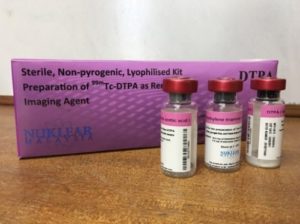
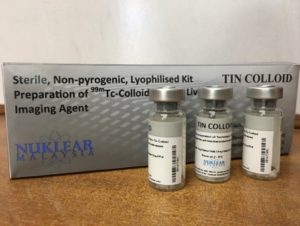
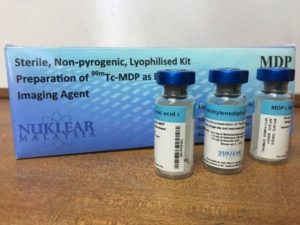

Product of radiopharmaceutical cold-kits
Environment, Water Resources and Climate Change
Water is a precondition for human, animal and plant life, as well as a necessary resource for the economic activities. Surface and groundwater resources are at risk because of indiscriminate use, rapidly growing populations, increasing agricultural demands, and threat of pollution in the surrounding areas. These risks are often compounded by a lack of understanding about local conditions governing the occurrence, distribution and management of surface and groundwater resources at large. Such hydrological problems in sustainable water resources development and management can be investigated and mostly solved by using nuclear-isotope techniques (environmental and radioisotope tracers). Nuclear Malaysia has been involved in assessment of groundwater, freshwater quality, salt water encroachment, Surface water / groundwater pollution, dam sustainability and safety and effects of climate change to marine ecosystem in various states as well as doing studies for water and agriculture authorities in Malaysia.
Food, Agriculture and Soil Management
Sustainable food supply is a precursor for human survival. Nuclear technology has been widely used for crop improvement, management of agro-ecosystems for productivity enhancement and development of radiation based bio products and bioprocesses. By exposing seeds or seedlings to certain level of radiation, new traits of plants that have superior characteristics compared to the original variety can be achieved. Exposing plants to different types of radiation, damages the plant’s DNA and causes new mutations resulting in a new useful trait. However, the plants are not contaminated or contain radioactive material, similarly as we undergo x-ray examination, only repairable minor cell damage may occur but our body does not become radioactive. Therefore the plants or grains produced are safe for human consumption. In Nuclear Malaysia the current focus for crop improvement is on rice, bananas, pineapple, kenaf and stevia for obtaining the characteristics required by the industry as well as to cope with climate change. As an example new rice variety with higher yield can be cultivated on dry land with water sprinkler instead of traditional irrigation system.
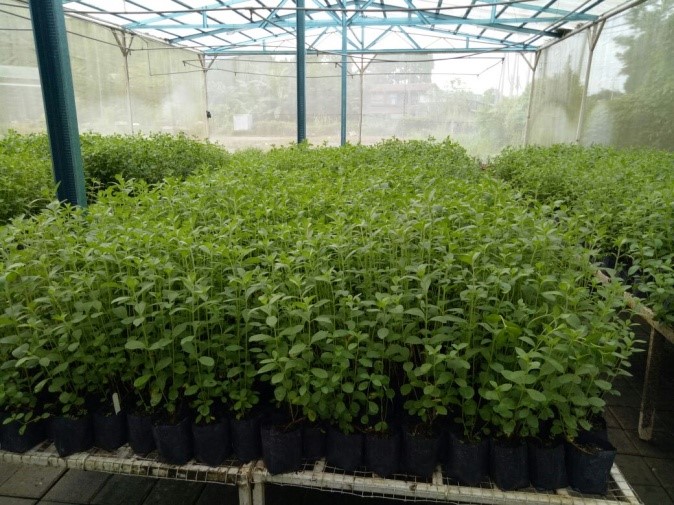
New variety of Stevia with higher biomass content produced using nuclear technology
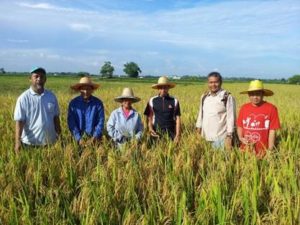
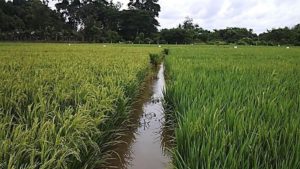
Field Trial of New Rice develop using nuclear science in Perlis

Plant growth promoter from irradiated chitosan
Food and agricultural product preservation are vital to ensure fresh food supply and reduce wastage. Food preservation using radiation technique has been accepted world-wide. In Malaysia, The Ministry of Health had approved this technique and sale of irradiated food under the Food Irradiation Regulations 2011. The demand for this preservation technique is growing steadily. In 2011 Nuclear Malaysia irradiated around 300 ton of food products and in 2015 it has grown to more than 1000 ton. The food products irradiated ranges from spices, herbs, as well as frozen foods. This has contributed substantially to Malaysian economy not only due to reduce wastage but also in terms of environmental sustainability where chemical free process is used. United States Department of Agriculture (USDA) requires fresh fruits imported from Malaysia to undergo irradiation to ensure that they are free of insects and meet the phytosanitary procedures. Malaysian Department of Agriculture has been working closely with Nuclear Malaysia to irradiate rambutan and to get USDA approval so that it can be exported to the US.


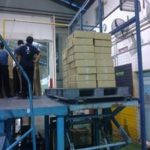
Mock trial on irradiation of Rambutan to meet US phytosanitary requirements
Clean Energy and Climate Change
Nuclear power is one of the lowest carbon technologies available to produce electricity in an affordable manner and can play a significant role in mitigating climate change. Nuclear power can make a significant contribution to reducing greenhouse gas emissions while delivering energy in the increasingly large quantities needed for growing populations and socioeconomic development. Nuclear power plants produce virtually no greenhouse gas emissions or air pollutants during their operation and only very low emissions over their entire life cycle. Despite of a relatively higher deployment cost compared to other power plants, issues of spent nuclear fuel, Fukushima and Chernobyl, as of May 2016, 30 countries worldwide are operating 444 nuclear reactors for electricity generation and 63 new nuclear reactors are under construction in 15 countries. This shows that the economic and public perception of nuclear power is still favourable, in many countries. South Korea with smaller land mass compared to Peninsula Malaysia, there are 25 nuclear power reactors in operation and 3 more are under construction.
In September 2010 Malaysia announced that post 2020 there will be 2 nuclear power reactors to be deployed to meet the growing demand of electricity and to reduce over dependence on fossil fuels such as coal, whereby 100% is imported. In Malaysia nuclear power program is under the purview of Malaysia Nuclear Power Corporation in the Prime Minister’s Department. The current revised plan is for Malaysia to start operating the first nuclear power plant by 2030.
Nuclear Malaysia has been operating a 1 MW research reactor for more than 30 years in a safe and peaceful manner. The knowledge and safety culture adopted and practised at Nuclear Malaysia is a strong foundation for public confidence. Furthermore understanding that strict adherence to regulatory procedures and compliance to international peer review regime has also contributed to safety and can further enhance public acceptance. Therefore Malaysian public should be ready to listen and analyse the risk mitigation, pros and cons of nuclear power in objective manner, so that the benefit of nuclear energy can be harnessed to ensure energy security and environmental sustainability. With that Malaysia can contribute immensely to the global effort in limiting green-house gas emission as well as combatting climate change.
Safety and Radiation Protection
In Malaysia there are more than 20,000 registered radiation workers involved in handling of tools and equipments with radioactive and radiation sources. Most of these workers are in hospitals, manufacturing and processing industries, airports, ports, research institutes, universities and so on. According to Malaysian Law, Acts 304 regulated by Atomic Energy Licensing Board (AELB) an agency under MOSTI, radiation workers are required to have a monitoring device to measure the total radiation dose received on a monthly basis. This device will be sent to the Nuclear Malaysia for the analysis and reading of the dose will be reported to AELB and MOH. Further investigation will be conducted if a worker received doses exceeding the permitted levels. Apart from monitoring of radiation workers, the working environment and the immediate vicinity are also monitored. Nuclear Malaysia has the expertise to carry out investigations in the case of excess radiation dose readings of radiation workers by looking at the chromosomal damage. This is done by chromosome aberration test at the Biological Dosimetry Laboratory. This laboratory was established in 1986 to meet the requirements of the Basic Safety Standards, Regulations on Radiation Protection and to support AELB and MOH. On average, the laboratory receives about ten blood samples for investigation per year.

Calibration of radiation measuring instruments
Since 1979, Nuclear Malaysia has conducted environmental radioactivity surveillance and monitoring program in the surrounding area including along the nearby Sungai Langat. Surveillance and monitoring program is carried out to detect any changes in the level of radioactivity in the environment that may results from the activities carried out in Nuclear Malaysia. Monitoring of environmental radiation and radioactivity is also implemented to meet the licensing requirements set by AELB. Until today the environmental radiation level recorded is lower than 20mSv/year and radioactivity level of samples within 10km radius is below 1Bq/gm similar to the natural background level in other countries. This shows that activities in Nuclear Malaysia do not release any radioactive materials, and hence, population within 5 km radius do not receive any extra radiation dose other than from the natural radiation.
Laboratories in Nuclear Malaysia that meet international standards are always in a state of readiness to carry out analysis when required. For example during the incident at Chernobyl and Fukushima, samples of food and goods imported from areas and countries near the nuclear incident were sent to Nuclear Malaysia to determine the level of radioactivity before selling was permitted. Malaysian citizens returning from nuclear accident affected areas may also get contamination checks at Nuclear Malaysia. Apart from That Nuclear Malaysia has also been providing analysis of radioactive material content in foods and drinks for exports if the importing country requires them.
Currently, Nuclear Malaysia is operating a large volume air sampler station to collect dust in the air and analyse it for atmospheric radioactive content if any. Any activities in the region such as nuclear explosion or any other minute radioactive releseas that may contaminate the environment can be detected and investigated. The station located at Cameron Highlands is own by an international body, Comprehensive Test Ban Treaty Organization (CTBTO). Currently there are 80 similar stations all over the world and the data from the stations are shared to all CTBTO member states which include Malaysia.

Powerful air sampler unit to collect air dust sample for atmospheric radioactive contamination detection and analysis at CTBTO station in Cameron Highlands
Conclusion
Although the world was introduced to nuclear by atomic bomb detonation, the technology has found numerous peaceful applications that benefit mankind. Being a member of IAEA Malaysia has been able to acquire expertise and nuclear technologies from advance countries through collaboration and training and applied these technologies locally. For the last 30 years nuclear science and technology has been safely and widely used in mainstream sectors of sosio-economic activities in Malaysia. Subsequently Malaysia is also developing her own indigenous nuclear technologies through R&D to enhance the effort towards achieving sustainable development goal. With proven safety record and applications benefitting the nation, Malaysian public should not be fearful and should be willing to learn and understand the risk mitigation and benefit of nuclear science and technology.
Article by YB Datuk Seri Panglima Wilfred Madius Tangau, Minister, Ministry of Science, Technology & Innovation (MOSTI) extracted from The Daily Express on 18 February 2017

Contact Details
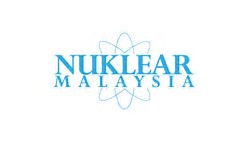
Agensi Nuklear Malaysia (Malaysian Nuclear Agency)
Bangi
43000 Kajang
Selangor
Tel: +603-8911 2000 / Fax: +603-8911 2175
Website: www.nuclearmalaysia.gov.my
Technical Visit to Agensi Nuklear Malaysia on 2nd March 2017
MASSA, together with the Malaysia-Japan Economic Association (MAJECA) and the Expertise Resource Association (ERA) organised a Technical Visit to Agensi Nuklear Malaysia (Malaysia Nuclear Agency) on 2 March 2017 from 10.00 am to 2.00 pm.
The Agensi Nuklear Malaysia (Nuklear Malaysia) is a premier research and development (R&D) organisation in nuclear science and technology. The agency plays an active role and contributes to the implementation and realisation of national science and technology (S&T) policies to ensure it remains a relevant public research institute for the country.
The functions of Agensi Nuklear Malaysia are as follows:
• To conduct research and development (R&D), services and training in the field of nuclear technology for national development;
• To encourage application, transfer and commercialisation of nuclear technology; and,
• To coordinate and manage the national and international nuclear affairs, and act as the liaison agency with International Atomic Energy Agency (IAEA) and Comprehensive Nuclear-Test-Ban Treaty Organization (CTBTO).
With more than three decades in operation, Nuklear Malaysia has matured and is capable of facing the challenges and managing the changes efficiently. In line with the current needs and development, a strategic action plan and its implementation has been developed to meet set targets. Nuklear Malaysia currently has four programmes, namely:
• research and technology development,
• technical and corporate support,
• transfer and commercialisation of technology planning,
• management services
These programmes will provide the means for Nuklear Malaysia to focus on its activities, including the readiness to be a technical support organisation, if Malaysia decides to embark on nuclear power programme as an alternative option for future electricity generation. For more detailed information, please visit Nuklear Malaysia’s website at http://www.nuclearmalaysia.gov.my/new/index.php .
The Agency’s 2015 Annual Report is available for your reference at http://www.nuclearmalaysia.gov.my/annual%20report/web/main.htm
Technology Planning and Development / Commercialisation of
Technology
The R&D activities of Nuklear Malaysia focus on six priority areas, namely, advanced material, advanced manufacturing, biotechnology, ICT, advanced alternative energy and nanotechnology. The R&D projects are market driven to produce beneficial products to generate economic returns through downstream activities. The implementation of R&D projects are periodically monitored and analysed to ensure that the projects are on the right track and meet the set target within the time frame. To strengthen project implementation and optimising resources sharing, several related projects have been consolidated into a few main projects, which will produce more significant socioeconomic impact. In this respect, apart from conducting collaborative research internally through the matrix system, research is also conducted through collaboration with other research organisations. Research collaborations with industrial partners have been also enhanced to produce research products that can be directly beneficial to end users. Thus, efforts have been made to ensure that research products can be commercialised through technology transfer and licensing. These activities will certainly augur well for the development of innovative technologies to enhance Malaysia’s products and services.
Malaysia has been gearing towards being a high-income nation and corporates in Malaysia need to take a leap to embrace new technologies to remain competitive. As such, the technical visit to Nuklear Malaysia was aimed to create more awareness and knowledge about the areas of focus and R&D components at Nuklear Malaysia and how corporations from various sectors, could adopt or play a part in the commercialisation possibilities of their R&D to upgrade and enhanced their products and services in niche areas to remain competitive in the global arena.
The Director-General, Dr Mohd Ashhar bin Hj Khalid and his management team met our delegation and gave a detailed briefing on the aims and functions of this organisation. Agensi Nuklear Malaysia hosted the participants to a luncheon after the briefing and tour.
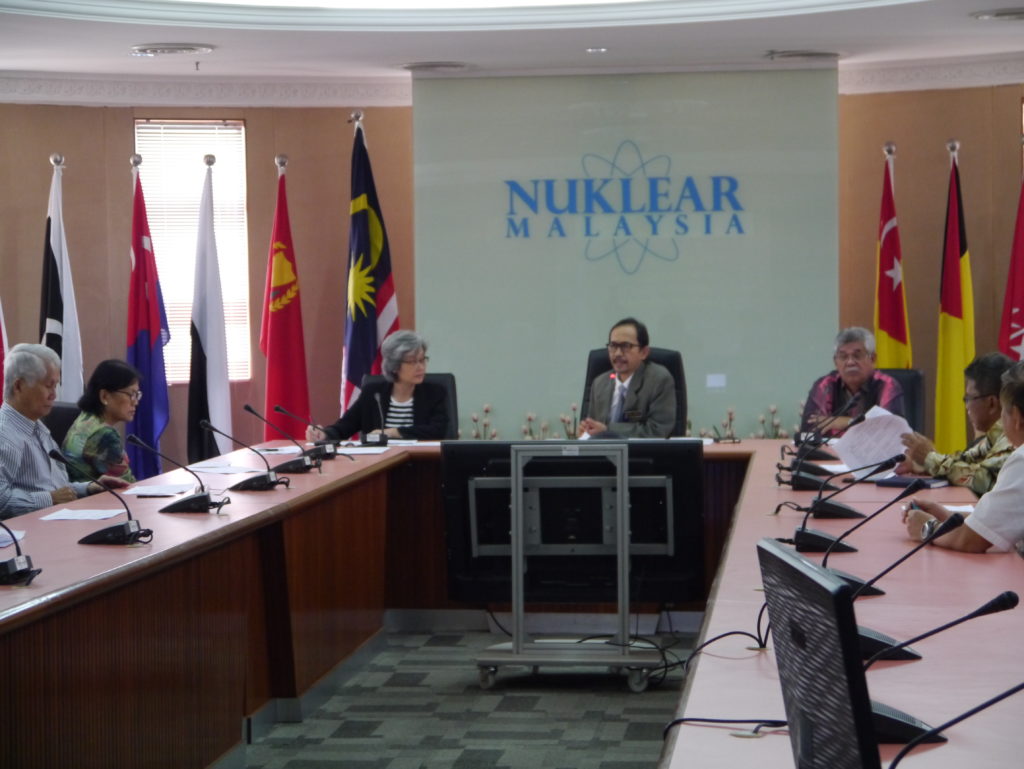
(Center) Dr Mohd Ashhar bin Hj Khalid, Director General, Agensi Nuklear Malaysia briefing MASSA members with (right) Ms Ng Su Fun, Executive Secretary of MASSA

(Left) Ms Ng Su Fun, Executive Secretary of MASSA presenting a souvenir to (right) Dr Mohd Ashhar bin Hj Khalid, Director General, Agensi Nuklear Malaysia

Group photo taken at the Agensi Nuklear Malaysia’s office
The participants toured the following facilities at Nuklear Malaysia:
1) SINAGAMA Irradiation Plant

2) Polymer blend and composites laboratory

3) The MINT Tech-park which houses a Flora Vitro Laboratory


4) The Gamma Greenhouse (GGH)
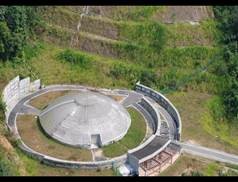
GAMMA Greenhouse

GAMMA Greenhouse inside view
5) Reaktor Triga PUSPATI (RTP) Facility or TRIGA PUSPATI Reactor



